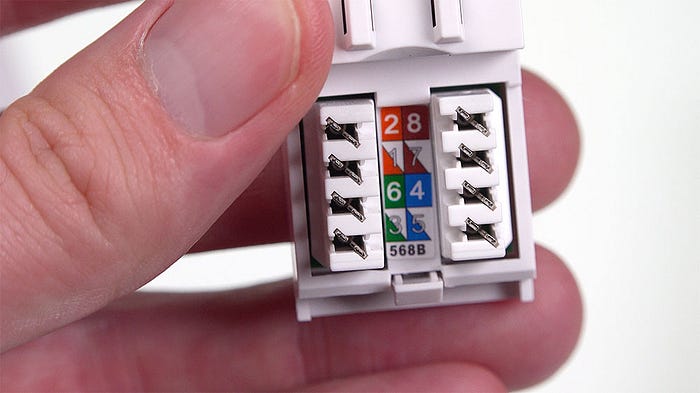How to Wire Up Ethernet Wall Jacks (Cat5e / Cat6 / Cat7 keystone jack wiring / punchdown tutorial)
How to punch down Cat5e, Cat6 or Cat7 cable to a keystone jack with RJ45 ethernet wall socket for your network cables
To wire up your own network sockets at each end of a long run of ethernet cable, you will need…
- https://geni.us/KeystoneJackRJ45 — An RJ45 keystone jack and wall plate
- A punchdown tool — I’d recommend investing in a really good quality one like this if you’ve got a lot of sockets to wire up or you’re going to be doing this fairly regularly. This one not only punches down but also trims the wires in the same step, and helps you get precise and reliable connections every time
- https://geni.us/Cat6 — A drum of Ethernet cable — probably either Cat5e, Cat6 or possibly even Cat6a, it will depend on your use case but we won’t get into the differences in this video
- https://geni.us/Snips — A pair of snips
- https://geni.us/WireStrippers — Some wire strippers
- https://geni.us/NetworkCableTester — Cable tester and two patch leads — this is essential to verify the cable run and all 8 connections in the sockets at each end are correctly wired up and working
The above links are affiliated which means we may earn a small commission, at no extra cost to you.
On the front of the keystone jack you’ll see a female RJ45 port and on the rear, you’ll see 8 metal grooves into which the 8 colour-coded twisted pairs of wires inside the network cable will be punched down. It’s very common for jacks to feature a colour-coded wiring diagram for your reference, sometimes with alternative wiring standards on. This one I bought handily has the colours laid out for the T568B wiring standard, which tends to be the most widely used.

So start off by punching out a hole in your back box and thread the network cable through both the back box and the wall plate. Then use the wire strippers to strip off about a 2 or 3 centimetre length of the outer jacket to reveal the 4 colour-coded twisted pairs of wire inside.
Snip off the plastic crosstalk separator being careful not to nick the wires, and then use the excess piece from the outer jacket to untwist the pairs of cable like this:
Some keystone jacks come with a small cable tie to hold the main cable in place and prevent it from straining, so thread that through the little hooks and then tie the cable firmly in place so the end of the outer jacket lines up just underneath the base of the punchdown area.
Then, arrange all 8 wires into their corresponding grooves based on the colour coding on the label. It’s important to make sure you wire up both ends to the same wiring standard, whether that’s T568A or T568B and regardless of whether the other end of the cable run is terminated on a wall socket or a male RJ45 plug.
Arrange the 8 wires with your fingers and press them down inside the grooves as far as they’ll go by hand whilst arranging them as neatly as you can without crossing over unnecessarily.
Once you’ve done that, use the punchdown tool to punch all 8 wires down which will splice the wires into the metal grooves, making an electrical connection and holding them firmly in place at the same time. If you’re using the punchdown tool that I’ve linked above, make sure you orient the blade side outwards so it can cut the wires making them easy to twist off and away afterwards leaving a neat, flush cut.
Don’t forget to snip the excess from the little cable tie then you can slide the keystone jack into the wall plate and clip into place, then screw the wall plate into the back box.
The next essential step is to test the connections at both ends of your cable run using a network cable tester to ensure everything is wired up correctly before you use it. You’ll need another patch lead to do this, or two patch leads if both ends of your cable run terminate to wall sockets.
The cable tester checks all 8 wires individually — it will tell you that the 8 connections are good on both ends and also that it’s wired up correctly on both ends in the right order — or at least the same order at both ends. It does this by sending a pulse down each wire in turn, from the Master to the Remote. You should see the sequence going repeatedly from 1 to 8, with a pause in between, at both ends of the cable, and when it does you know that the cable is working perfectly. If it’s a long cable run — and both Cat5e and Cat6 cable are good for 100m — then you can separate the Master and Remote parts of the cable tester and put one at each end of the cable run to test it.
Depending on how you’re building your setup, you might sometimes need to put a male RJ45 plug on the end of a long cable rather than a wall socket. In that case, there are two slightly different kinds of RJ45 plugs you can choose from; either standard RJ45 plugs or pass-through plugs, sometimes also called Snap Plugs or EZ Plugs.
Purchasing Links: (paid)
➡ CAT5e and CAT6/6A Punchdown Tool: https://geni.us/PunchdownTool
➡ RJ45 Network Wall Face Plate: https://geni.us/KeystoneJackRJ45
➡ Ethernet Cable Tester: https://geni.us/NetworkCableTester
➡ Cat6 Ethernet Cable: https://geni.us/Cat6
➡ Wire Cutters / Snips: https://geni.us/Snips
DISCLOSURE: As an Amazon Associate we earn from qualifying purchases.
Originally published at https://www.switchedonnetwork.com on November 29, 2021.
